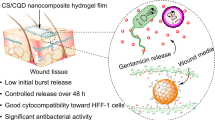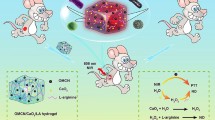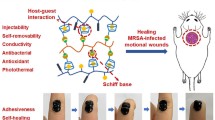Abstract
The abuse of antibiotics in treating microbial infections has led to the emergence and prevalence of drug-resistant bacteria. Thus, the development of novel antibacterial materials is attracting increasing attention. Here, a series of flexible electrostatic hydrogels with excellent antibacterial ability were constructed using a mixture of nitric oxide (NO)-releasing nitrated chitosan (CSNO) and mesotetra(4-carboxyphenyl)porphine (TCPP) with salmon sperm DNA (ssDNA) solution. When cultured with gram-negative bacteria under solar simulator irradiation, TCPP-CSNOm-ssDNAn hydrogels released reactive oxygen species (ROS) and NO to produce peroxynitrite ions (ONOO−). ONOO− is efficient at killing bacteria, thereby improving the antimicrobial ability of photodynamic therapy against gram-negative bacteria. The hydrogels exhibited powerful antibacterial activity in vivo when used to treat skin infections caused by drug-resistant bacteria, making them a promising candidate for clinical applications. A string of antibacterial hydrogels that release ROS and NO synergistically can bring new possibilities for effectively killing drug-resistant bacteria and be of great value in anti-infection wound dressings and other applications.

摘要
在治疗微生物感染疾病方面滥用抗生素提高了耐药菌的致病率. 本研究提出了一种利用硝化壳聚糖与鱼精DNA包裹光敏剂构建静电水凝胶(TCPP-CSNOm-ssDNAn)的策略. 在模拟太阳光的照射下, 水凝胶TCPP-CSNOm-ssDNAn释放一氧化氮与活性氧物质, 进而形成具有强氧化活性的过氧亚硝酸盐离子(OONO−), 实现了高效协同杀灭多药耐药革兰氏阴性菌的作用, 改善了单一的光动力治疗对革兰氏阴性菌效果不佳的现状. 在用于治疗由多药耐药的铜绿假单胞菌引起的皮肤感染时, 水凝胶TCPP-CSNO2-ssDNA1在体内表现出有效的抗菌作用, 同时具有生物安全性, 这使其在抗感染伤口敷料领域具有巨大的应用潜力.
Similar content being viewed by others
References
Iwase T, Uehara Y, Shinji H, et al. Staphylococcus epidermidis Esp inhibits Staphylococcus aureus biofilm formation and nasal colonization. Nature, 2010, 465: 346–349
Xie X, Sun TC, Xue J, et al. Ag nanoparticles cluster with pH-triggered reassembly in targeting antimicrobial applications. Adv Funct Mater, 2020, 30: 2000511
Zhu YW, Sun YJ, Wang JL, et al. Antimicrobial and antifouling surfaces through polydopamine bio-inspired coating. Rare Met, 2021, 41: 499–518
Hu J, Zhang C, Zhou L, et al. A smart hydrogel for on-demand delivery of antibiotics and efficient eradication of biofilms. Sci China Mater, 2021, 64:1035–1046
Baym M, Stone LK, Kishony R. Multidrug evolutionary strategies to reverse antibiotic resistance. Science, 2015, 351: 3292
Brown ED, Wright GD. Antibacterial drug discovery in the resistance era. Nature, 2016, 529: 336–343
Kaki R, Elligsen M, Walker S, et al. Impact of antimicrobial stewardship in critical care: A systematic review. J AntiMicrob ChemoTher, 2011, 66: 1223–1230
Ray PC, Khan SA, Singh AK, et al. Nanomaterials for targeted detection and photothermal killing of bacteria. Chem Soc Rev, 2012, 41: 3193–3209
Song M, Liu Y, Huang X, et al. A broad-spectrum antibiotic adjuvant reverses multidrug-resistant gram-negative pathogens. Nat Microbiol, 2020, 5: 1040–1050
Cheng X, Zhang S, Liu H, et al. Biomimetic metal-organic framework composite-mediated cascade catalysis for synergistic bacteria killing. ACS Appl Mater Interfaces, 2020, 12: 36996–37005
Gehring J, Trepka B, Klinkenberg N, et al. Sunlight-triggered nanoparticle synergy: Teamwork of reactive oxygen species and nitric oxide released from mesoporous organosilica with advanced antibacterial activity. J Am Chem Soc, 2016, 138: 3076–3084
Zhu Y, Xu C, Zhang N, et al. Polycationic synergistic antibacterial agents with multiple functional components for efficient anti-infective therapy. Adv Funct Mater, 2018, 28: 1706709
Wang Z, Xu FJ, Yu B. Smart polymeric delivery system for antitumor and antimicrobial photodynamic therapy. Front Bioeng Biotechnol, 2021, 9: 783354
Huang L, Huang YY, Mroz P, et al. Stable synthetic cationic bacteriochlorins as selective antimicrobial photosensitizers. Antimicrob Agents Chemother, 2010, 54: 3834–3841
Wu S, Xu C, Zhu Y, et al. Biofilm-sensitive photodynamic nanoparticles for enhanced penetration and antibacterial efficiency. Adv Funct Mater, 2021, 31: 2103591
Yuan Z, Lin C, He Y, et al. Near-infrared light-triggered nitric-oxide-enhanced photodynamic therapy and low-temperature photothermal therapy for biofilm elimination. ACS Nano, 2020, 14: 3546–3562
Virág L, Szabó É, Gergely P, et al. Peroxynitrite-induced cytotoxicity: Mechanism and opportunities for intervention. Toxicol Lett, 2003, 140–141: 113–124
Wang D, Niu L, Qiao ZY, et al. Synthesis of self-assembled porphyrin nanoparticle photosensitizers. ACS Nano, 2018, 12: 3796–3803
Szabó C, Ischiropoulos H, Radi R. Peroxynitrite: Biochemistry, pathophysiology and development of therapeutics. Nat Rev Drug Discov, 2007, 6: 662–680
Li Y, Liu X, Li B, et al. Near-Infrared light triggered phototherapy and immunotherapy for elimination of methicillin-resistant Staphylococcus aureus biofilm infection on bone implant. ACS Nano, 2020, 14: 8157–8170
Cheng D, Pan Y, Wang L, et al. Selective visualization of the endogenous peroxynitrite in an inflamed mouse model by a mitochondria-targetable two-photon ratiometric fluorescent probe. J Am Chem Soc, 2017, 139: 285–292
Chen H, Li S, Wu M, et al. Membrane-anchoring photosensitizer with aggregation-induced emission characteristics for combating multidrug-resistant bacteria. Angew Chem Int Ed, 2020, 59: 632–636
Zhang X, Xia LY, Chen X, et al. Hydrogel-based phototherapy for fighting cancer and bacterial infection. Sci China Mater, 2017, 60: 487–503
Maleki A, He J, Bochani S, et al. Multifunctional photoactive hydrogels for wound healing acceleration. ACS Nano, 2021, 15: 18895–18930
Cao Z, Luo Y, Li Z, et al. Antibacterial hybrid hydrogels. Macromol Biosci, 2021, 21: 2000252
Wang H, Xu Z, Zhao M, et al. Advances of hydrogel dressings in diabetic wounds. Biomater Sci, 2021, 9: 1530–1546
Zhao X, Guo B, Wu H, et al. Injectable antibacterial conductive nanocomposite cryogels with rapid shape recovery for noncompressible hemorrhage and wound healing. Nat Commun, 2018, 9: 2784
Wang J, Du W, Zhang Z, et al. Biomass/polyhedral oligomeric silses-quioxane nanocomposites: Advances in preparation strategies and performances. J Appl Polym Sci, 2021, 138: 49641
Chen G, Wang L, Cordie T, et al. Multi-functional self-fluorescent unimolecular micelles for tumor-targeted drug delivery and bioimaging. Biomaterials, 2015, 47: 41–50
Li Y, Zhang J, Guo Y, et al. Cellulosic micelles as nanocapsules of liposoluble CdSe/ZnS quantum dots for bioimaging. J Mater Chem B, 2016, 4: 6454–6461
Jiang L, Sheng L, Fan Z. Biomass-derived carbon materials with structural diversities and their applications in energy storage. Sci China Mater, 2018, 61: 133–158
Wang Y, Liang Z, Su Z, et al. All-biomass fluorescent hydrogels based on biomass carbon dots and alginate/nanocellulose for biosensing. ACS Appl Bio Mater, 2018, 1: 1398–1407
Wang K, Zhang X, Zhang X, et al. Fluorescent glycopolymer nanoparticles based on aggregation-induced emission dyes: Preparation and bioimaging applications. Macromol Chem Phys, 2015, 216: 678–684
Liu Z, Guo K, Zhao N, et al. Polysaccharides-based nanohybrids: Promising candidates for biomedical materials. Sci China Mater, 2019, 62: 1831–1836
Abdelhamid HN, Wu HF. Probing the interactions of chitosan capped CdS quantum dots with pathogenic bacteria and their biosensing application. J Mater Chem B, 2013, 1: 6094
Jayakumar R, Menon D, Manzoor K, et al. Biomedical applications of chitin and chitosan based nanomaterials—A short review. Carbohydrate Polyms, 2010, 82: 227–232
Liu Y, Xiao Y, Cao Y, et al. Construction of chitosan-based hydrogel incorporated with antimonene nanosheets for rapid capture and elimination of bacteria. Adv Funct Mater, 2020, 30: 2003196
Liu S, Cai X, Xue W, et al. Chitosan derivatives co-delivering nitric oxide and methicillin for the effective therapy to the methicillin-resistant S. aureus infection. Carbohydrate Polyms, 2020, 234: 115928
Pelegrino MT, Pieretti JC, Nakazato G, et al. Chitosan chemically modified to deliver nitric oxide with high antibacterial activity. Nitric Oxide, 2021, 106: 24–34
Chen J, Wang Y, Niu H, et al. Metal-organic framework-based nanoagents for effective tumor therapy by dual dynamics-amplified oxidative stress. ACS Appl Mater Interfaces, 2021, 13: 45201–45213
Wang B, Dai Y, Kong Y, et al. Tumor microenvironment-responsive Fe (III)-porphyrin nanotheranostics for tumor imaging and targeted chemodynamic-photodynamic therapy. ACS Appl Mater Interfaces, 2020, 12: 53634–53645
Wan SS, Cheng Q, Zeng X, et al. A Mn(III)-sealed metal-organic framework nanosystem for redox-unlocked tumor theranostics. ACS Nano, 2019, 13: 6561–6571
Deepagan VG, Ko H, Kwon S, et al. Intracellularly activatable nanovasodilators to enhance passive cancer targeting regime. Nano Lett, 2018, 18: 2637–2644
Huang Y, Ding X, Qi Y, et al. Reduction-responsive multifunctional hyperbranched polyaminoglycosides with excellent antibacterial activity, biocompatibility and gene transfection capability. Biomaterials, 2016, 106: 134–143
Hetrick EM, Shin JH, Stasko NA, et al. Bactericidal efficacy of nitric oxide-releasing silica nanoparticles. ACS Nano, 2008, 2: 235–246
Backlund CJ, Worley BV, Schoenfisch MH. Anti-biofilm action of nitric oxide-releasing alkyl-modified poly(amidoamine) dendrimers against Streptococcus mutans. Acta Biomater, 2016, 29: 198–205
Wang W, Yu B, Sun W, et al. Bioinspired nanostructured spiderweb for high-efficiency capturing and killing of bacteria. Sci China Mater, 2022, 65: 518–526
Zheng K, Li S, Jing L, et al. Synergistic antimicrobial titanium carbide (MXene) conjugated with gold nanoclusters. Adv Healthcare Mater, 2020, 9: 2001007
Zhao L, Yang Q, Guo W, et al. Co2.67S4-based photothermal membrane with high mechanical properties for efficient solar water evaporation and photothermal antibacterial applications. ACS Appl Mater Interfaces, 2019, 11: 20820–20827
Miao Z, Fan L, Xie X, et al. Liquid exfoliation of atomically thin antimony selenide as an efficient two-dimensional antibacterial nanoagent. ACS Appl Mater Interfaces, 2019, 11: 26664–26673
Tan L, Li J, Liu X, et al. Rapid biofilm eradication on bone implants using red phosphorus and near-infrared light. Adv Mater, 2018, 30: 1801808
Liu P, Wang Y, An L, et al. Ultrasmall WO3−x@γ-poly-L-glutamic acid nanoparticles as a photoacoustic imaging and effective photothermal-enhanced chemodynamic therapy agent for cancer. ACS Appl Mater Interfaces, 2018, 10: 38833–38844
Fan X, Yang F, Huang J, et al. Metal-organic-framework-derived 2D carbon nanosheets for localized multiple bacterial eradication and augmented anti-infective therapy. Nano Lett, 2019, 19: 5885–5896
Acknowledgements
This work was supported by the National Key R&D Program of China (2021YFB3800900), the National Natural Science Foundation of China (22122501, 21875014 and 52073013), and Beijing Outstanding Young Scientist Program (BJJWZYJH01201910010024).
Author information
Authors and Affiliations
Contributions
Xu FJ and Yu B directed the research. Sun Y and Wen RL contributed equally to the preparation and characterization of hydrogels. Yu D, Zhu Y and Zheng L helped to accomplish biocompatibility and in vivo tests. Wang H helped to analyze the data. Liu X offered experimental materials.
Corresponding authors
Additional information
Conflict of interest
The authors declare that they have no conflict of interest.
Supplementary information
Experimental details and supporting data are available in the online version of the paper.
Yujie Sun received her BSc degree from Yanshan University in 2018. She is currently a doctor student under the supervision of Prof. Fu-Jian Xu and Prof. Bingran Yu at Beijing University of Chemical Technology. Her research interests focus on photodynamic antibacterial polymers and cationic polymers for biomacromolecule delivery.
Rong-Lai Wen received his master’s degree from Beijing University of Chemical Technology in 2021. His research interests focus on polysaccharide-based biomass hydrogels for photodynamic antibacterial effect.
Bingran Yu is currently a professor at Beijing University of Chemical Technology. He obtained his PhD degree in inorganic chemistry from Lanzhou University in 2013 and then joined Beijing University of Chemical Technology. Prof. Yu has contributed significantly to the field of design, construction, and application of drug/gene delivery vectors and novel antibacterial polymers.
Fu-Jian Xu is currently a professor at Beijing University of Chemical Technology. He obtained his PhD degree in biomolecular engineering in 2006 from the National University of Singapore. He joined Beijing University of Chemical Technology, China as a professor in 2009. He was recipient of the National Science Foundation for Distinguished Young Scholars (NSFC, 2013) and Cheung Kong Distinguished Professor (Ministry of Education of China, 2014). His research interests focus on functional bio-macromolecules.
Supporting Information
40843_2022_2024_MOESM1_ESM.pdf
Flexible electrostatic hydrogels from marine organism for nitric oxide-enhanced photodynamic therapy against multidrug-resistant bacterial infection
Rights and permissions
About this article
Cite this article
Sun, Y., Wen, RL., Yu, D. et al. Flexible electrostatic hydrogels from marine organism for nitric oxide-enhanced photodynamic therapy against multidrug-resistant bacterial infection. Sci. China Mater. 65, 2850–2860 (2022). https://doi.org/10.1007/s40843-022-2024-6
Received:
Accepted:
Published:
Issue Date:
DOI: https://doi.org/10.1007/s40843-022-2024-6




